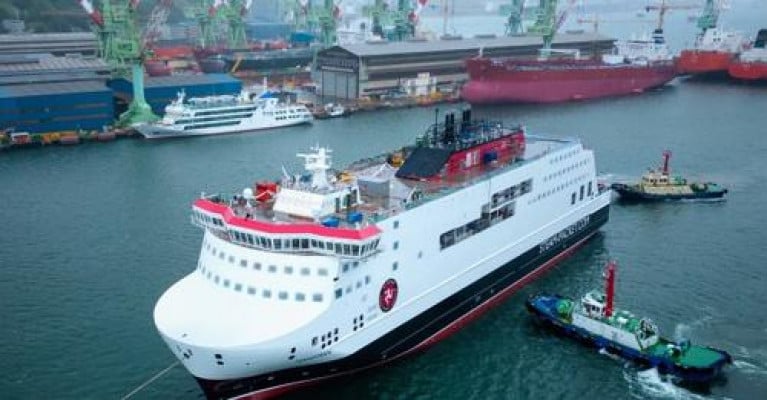Displaying items by tag: FloatedOut
The new Isle of Man Steam Packet Company's ferry has reached the completion phase of dry-building at an Asian shipyard with the company celebrating this key event of the Manxman's construction process.
Despite the extreme challenges posed by the global COVID-19 pandemic, Manxman floated out of drydock on 14th June, exactly on schedule. The custom-built ferry was taken by tugs to an outfitting berth where the next phase of the build has commenced.
The official certificate of launching was presented to Jim Royston, Isle of Man Steam Packet Company’s Fleet Operations and Project Manager, in a ceremony held to mark the occasion by HD Shin, President and CEO of HMD Dock Yard.
Brian Thomson, Managing Director of the Steam Packet Company, said: ‘The contract with the shipyard was signed two years ago now, in that contract 14th June 2022 was specified for the launch of Manxman and we are immensely proud as a company, to have achieved that milestone. This has been achieved despite facing closed borders, travel restrictions and global supply chain issues. For everyone working on the project this is a remarkable achievement.’
‘We look forward to sharing details of Manxman’s continued development and ultimate delivery to Manx waters in 2023.”
Afloat.ie adds the Manxman is to enter service on the company's main year round operated Douglas-Heysham route where the Manx-England link is currently served by ro-pax Ben-My-Chree which entered service in 1998.
To keep abreast of further phases on the Manxman, the Steam-Packet has a blog for the latest progress updates.
#Navy - The latest Irish Naval Service newbuild, LÉ George Bernard Shaw was floated-out for the first time from a UK shipyard, writes Jehan Ashmore.
LÉ George Bernard Shaw costing €67m, is the fourth of the offshore patrol vessel (OPV90 / 'Samuel Beckett') class sisters to be built by Babcock Marine & Technology shipyard in Appledore, north Devon. The shipyard group which has several facilities throughout the UK won the contract to build the vessel last year.
The OPV was towed by the stern from the building hall in Bidna on the Torridge Estuary near Bideford. The operation which took place last Friday involved the 90 metre newbuild to be towed to the yard's fitting-out quay which was completed as daylight appeared.
Following sea trials the 2,256 tonnes LÉ George Bernard Shaw which will have a crew of 44, is due to be handed over to the INS later this summer.
The Naval Base on Haubowline Island in lower Cork Harbour is where LÉ George Bernard Shaw will join fleetmates, among them LÉ William Butler Yeats. This is the last sister completed by Babcock and Afloat has drone footage capturing the carefull berthing of the OPV at her homeport with the aid of a tug.
A pennant number of (P64) adorns the bows of the sleek looking LÉ George Bernard Shaw which was named in honour of the Irish playright at a keel-laying ceremony last year.
The newbuild follows sisters all named after fellow literary giants: the leadship LÉ Samuel Beckett delivered in 2014, LÉ James Joyce in 2015 and the last to enter service the aforementioned LÉ William Butler Yeats which was commissioned in 2016.
The new patrol vessel will have a comprehensive command, control and communications package along with a main weapon of a bow-mounted 76mm gun. At the time of the float-out this armament had yet to be fitted in addition the mainmast (lying on the fit-out quayside) had yet to be installed.
As for speed the twin-screw OPV will reach 23 knots and a 6,000 miles range is based on a cruising speed of 15 knots. Accommodation for the 44 crew will also cater for an additional 10 trainee berths.
A suite of three rigid inflatable boats on board will serve a variety of tasks for the LÉ George Bernard Shaw which will be able to act as a mother ship.
When LÉ George Bernard Shaw is commissioned into service, the OPV will become the sixth OPV built ship for the current INS fleet. The introduction of the 'Playrights' is part of a vessel replacement /modernisation programme that has seen all of the ageing 'Emer' class OPV's disposed in recent years.
The rest of the fleet comprises of a pair OPV80 class offshore patrol vessels, two coastal patrol vessels and a single helicopter patrol vessel.
























































